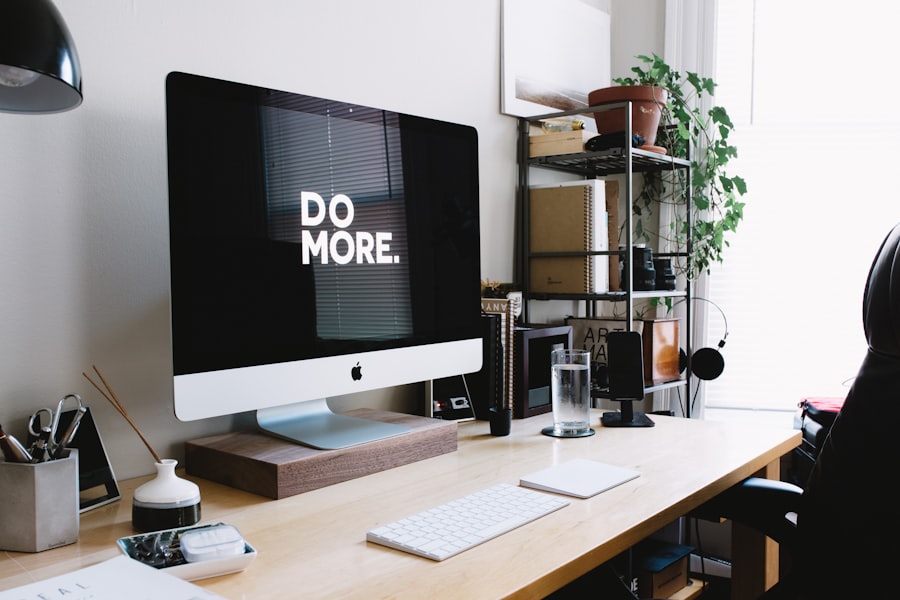In today’s fast-paced world, the concept of work-life balance has become increasingly vital. You may find yourself juggling multiple responsibilities, from professional obligations to personal commitments, and it can often feel overwhelming. Achieving a harmonious balance between your work and personal life is essential not only for your mental well-being but also for your overall productivity.
When you prioritize work-life balance, you create a healthier environment for yourself, allowing you to recharge and approach your tasks with renewed energy and focus. Moreover, maintaining this balance can lead to improved relationships with family and friends. When you allocate time for both work and leisure, you foster deeper connections with those around you.
You may notice that when you are more present in your personal life, it positively impacts your professional performance as well. By understanding the importance of work-life balance, you set the foundation for a fulfilling life where both your career aspirations and personal happiness coexist harmoniously.
Key Takeaways
- Work-life balance is crucial for overall well-being and productivity.
- Setting realistic goals and priorities helps in managing time effectively.
- A structured daily routine can improve efficiency and reduce stress.
- Utilizing time management techniques can help in achieving work-life balance.
- Taking regular breaks and rest is essential for maintaining mental and physical health.
Setting Realistic Goals and Priorities
To achieve a sustainable work-life balance, it is crucial to set realistic goals and priorities. You might start by evaluating your current commitments and determining what truly matters to you. This process involves identifying your short-term and long-term objectives, both professionally and personally.
By establishing clear priorities, you can focus your energy on what is most important, ensuring that you do not become overwhelmed by less significant tasks. Additionally, it is essential to be flexible with your goals. Life is unpredictable, and circumstances can change rapidly.
You may find that some goals need to be adjusted or even abandoned in favor of more pressing matters. By being adaptable and open to change, you can maintain a sense of control over your life while still pursuing your ambitions. Remember, setting realistic goals is not about limiting yourself; it’s about creating a roadmap that allows you to navigate the complexities of life with confidence.
Creating a Structured Daily Routine

Establishing a structured daily routine can significantly enhance your work-life balance.
A well-organized routine can provide a sense of stability in your day-to-day life, making it easier to transition between different roles and responsibilities.
When creating your routine, consider incorporating time blocks for various activities. For instance, you might designate certain hours for focused work, followed by breaks for relaxation or exercise. By structuring your day in this manner, you can minimize distractions and maximize productivity.
Additionally, having a routine can help you establish boundaries between work and personal time, ensuring that you are fully present in each aspect of your life.
Utilizing Time Management Techniques
| Technique | Effectiveness | Benefits |
|---|---|---|
| Prioritizing tasks | High | Increased productivity, reduced stress |
| Setting goals | Medium | Improved focus and motivation |
| Time blocking | High | Better time management, reduced multitasking |
| Eliminating distractions | High | Improved concentration, faster task completion |
Effective time management techniques are essential tools for achieving work-life balance. You may want to explore various strategies that can help you optimize your time and increase efficiency. One popular method is the Pomodoro Technique, which involves working in focused intervals followed by short breaks.
Another valuable technique is prioritizing tasks using the Eisenhower Matrix, which categorizes tasks based on their urgency and importance. By identifying what needs immediate attention versus what can wait, you can allocate your time more wisely.
Implementing these time management techniques not only helps you stay organized but also empowers you to take control of your schedule, ultimately leading to a more balanced life.
Taking Regular Breaks and Rest
In the pursuit of work-life balance, taking regular breaks and ensuring adequate rest is paramount. You might be tempted to push through long hours of work without pausing, believing that it will lead to greater productivity. However, research shows that taking breaks can actually enhance focus and creativity.
By stepping away from your tasks periodically, you allow your mind to reset and recharge, leading to improved performance when you return. Moreover, prioritizing rest is equally important. You may find that getting enough sleep each night significantly impacts your mood, cognitive function, and overall well-being.
Establishing a bedtime routine that promotes relaxation can help ensure that you wake up refreshed and ready to tackle the day ahead. Remember, rest is not a luxury; it is a necessity for maintaining a healthy work-life balance.
Avoiding Multitasking and Focusing on Single Tasking

In an age where multitasking is often glorified, it’s essential to recognize the benefits of focusing on single tasking instead. You may believe that juggling multiple tasks at once will make you more efficient; however, studies indicate that multitasking can lead to decreased productivity and increased stress levels. By concentrating on one task at a time, you can devote your full attention to it, resulting in higher quality work and a greater sense of accomplishment.
To practice single tasking effectively, consider eliminating distractions from your environment. This might involve turning off notifications on your devices or creating a dedicated workspace free from interruptions. By fostering an environment conducive to focus, you empower yourself to engage fully with each task at hand.
Embracing single tasking not only enhances your productivity but also contributes to a more balanced approach to work and life.
Implementing Stress-Relief Strategies
Stress is an inevitable part of life, but how you manage it can significantly impact your work-life balance. You may want to explore various stress-relief strategies that resonate with you personally. Activities such as exercise, deep breathing exercises, or engaging in hobbies can serve as effective outlets for stress relief.
Finding what works best for you is key; whether it’s going for a run or practicing yoga, incorporating these activities into your routine can help mitigate stress levels. Additionally, consider integrating relaxation techniques into your daily life. Mindfulness practices such as meditation or journaling can provide valuable moments of reflection and calm amidst the chaos of daily responsibilities.
By actively seeking out stress-relief strategies that resonate with you, you create a buffer against the pressures of work and life, ultimately fostering a healthier balance.
Seeking Support and Delegating Tasks
Recognizing when to seek support and delegate tasks is crucial for maintaining work-life balance. You may feel inclined to take on every responsibility yourself; however, this approach can lead to burnout and overwhelm. It’s important to acknowledge that asking for help is not a sign of weakness but rather a strength that allows you to manage your workload more effectively.
Consider reaching out to colleagues or family members when you need assistance with specific tasks or projects. Delegating responsibilities not only lightens your load but also fosters collaboration and teamwork. By sharing the burden with others, you create an environment where everyone can contribute their strengths while allowing yourself the space to focus on what truly matters.
Embracing a Healthy Lifestyle
A healthy lifestyle plays a pivotal role in achieving work-life balance. You may find that incorporating nutritious foods into your diet enhances your energy levels and overall well-being. Prioritizing physical activity is equally important; regular exercise not only boosts your mood but also improves cognitive function and reduces stress levels.
Additionally, consider the impact of hydration on your daily performance. Staying adequately hydrated can enhance focus and concentration throughout the day. By embracing a healthy lifestyle that includes balanced nutrition, regular exercise, and proper hydration, you equip yourself with the tools necessary to navigate the demands of both work and personal life effectively.
Practicing Mindfulness and Meditation
Mindfulness and meditation are powerful practices that can significantly contribute to achieving work-life balance. You may find that dedicating even just a few minutes each day to mindfulness exercises helps ground you in the present moment. This practice allows you to cultivate awareness of your thoughts and feelings without judgment, promoting a sense of calm amidst the busyness of life.
Meditation can also serve as an effective tool for managing stress and enhancing focus. By incorporating meditation into your daily routine—whether through guided sessions or silent reflection—you create space for mental clarity and emotional resilience. As you develop these practices over time, you may notice an increased ability to handle challenges with grace while maintaining a balanced perspective on both work and life.
Recognizing the Signs of Burnout and Knowing When to Seek Help
Finally, recognizing the signs of burnout is crucial for maintaining work-life balance. You may experience symptoms such as chronic fatigue, irritability, or decreased motivation when overwhelmed by stressors in both work and personal life. It’s essential to listen to these signals from your body and mind; they often indicate that it’s time to reassess your commitments and prioritize self-care.
If you find yourself struggling with burnout despite implementing various strategies for balance, don’t hesitate to seek help from professionals or support networks. Talking to a therapist or counselor can provide valuable insights into managing stressors effectively while offering guidance tailored specifically to your situation. Remember that seeking help is not a sign of failure; rather, it demonstrates strength in recognizing when additional support is needed on your journey toward achieving a healthier work-life balance.
In conclusion, achieving work-life balance requires intentional effort across various aspects of your life. By understanding its importance, setting realistic goals, creating structured routines, utilizing time management techniques, taking breaks, focusing on single tasks, implementing stress-relief strategies, seeking support, embracing healthy lifestyles, practicing mindfulness, and recognizing signs of burnout—you empower yourself to lead a more balanced and fulfilling life.
In today’s fast-paced world, maintaining productivity without succumbing to burnout is a crucial skill. One effective strategy is to incorporate regular breaks and mindfulness practices into your daily routine. For more insights on achieving this balance, you might find the article on Productive Patty particularly helpful. It offers practical tips and techniques to enhance productivity while ensuring you remain energized and focused throughout the day. By implementing these strategies, you can work efficiently without compromising your well-being.
WATCH THIS! 🌈🌈🌈🌈🌈🌈The LIE That Keeps You Burned Out: Why Your Productivity Shame Is a Trap
FAQs
What is burnout?
Burnout is a state of emotional, physical, and mental exhaustion caused by excessive and prolonged stress. It occurs when you feel overwhelmed, emotionally drained, and unable to meet constant demands.
What are the signs of burnout?
Signs of burnout include feeling exhausted all the time, feeling detached and cynical about work, feeling ineffective and unaccomplished, and experiencing physical symptoms such as headaches or stomachaches.
How can I be productive without burning out?
To be productive without burning out, it’s important to prioritize self-care, set boundaries, delegate tasks, take regular breaks, and practice time management. It’s also important to communicate with your colleagues and supervisors about your workload and seek support when needed.
What are some self-care practices to prevent burnout?
Self-care practices to prevent burnout include getting enough sleep, eating a balanced diet, exercising regularly, practicing mindfulness or meditation, and engaging in activities that bring you joy and relaxation.
How can I set boundaries to prevent burnout?
Setting boundaries to prevent burnout involves learning to say no to additional tasks when you’re already overwhelmed, establishing a work-life balance, and communicating your limits to others. It’s important to prioritize your well-being and not overextend yourself.
What role does time management play in preventing burnout?
Effective time management can help prevent burnout by allowing you to prioritize tasks, set realistic goals, and avoid overcommitting yourself. It’s important to schedule regular breaks and avoid multitasking, which can lead to increased stress and decreased productivity.




